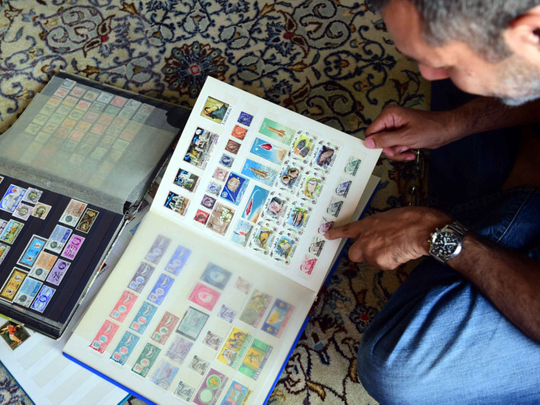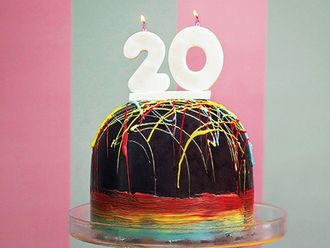
Dubai: It started as an idea, as all endeavours do, and turned into a significant chronicle of history, in this instance, of the UAE.
For Ammar Shams, philately or collecting postage stamps, began as a hobby at a young age.
“When I was three or four years old, dad used to bring stamps in from the office,” says the 52-year Shams. His late father, who worked in British Petroleum and later as a banker, believed at the time that stamp collecting would be a good hobby for his young son.
“All the envelopes of the letters that used to come to his office, he’d bring them home, I’d cut out the stamps, put them in water to get the stamp to peel off and dry them and place them in albums,” he says.
Shams, a Bahraini-born Emirati, is seated on the floor with his vast collection of stamps preserved in dozens of albums spread around him.
”As a stamp collector, your ideal is to get one that is worth a thousand times its value. That’s what you live for [as a collector],” he says.
But for Shams, who retired early this year — “I chill,” he says, when asked to describe how he spends his time — money does not seem to be his main motivation.
Instead, he prefers to use his stamps to help explain how the UAE came into being. His favourite stamp, issued in Dubai in 1965, shows the rulers of nine emirates — the seven member emirates of the UAE, as well as Bahrain and Qatar. It was a period when the British rule here was about to begin its fadeout.
Three years later, in January 1968, British troops left what London referred to as ‘East of Aden’.
The rare stamp, which suggests a future federation stretching from Bahrain to Fujairah, represents “what could have been”, he says.
In the early years, after the Second World War, Gulf emirates would commonly use stamps from colonial India, sometimes with the name of the emirate printed on top. Then, when India achieved independence, most emirates switched to British stamps.
From 1963, the emirates began to print their own stamps — even Umm Al Quwain, which had a population of only around 7,000 people at the time.
These stamps were often a matter of prestige rather than practicality.
“For a lot of people, you are a country when you have a flag, when you have a currency, and when you print your own stamps,” says Shams, with a smile.
As well as their own stamps, most of the emirates had their own flags too. And in 1966, Qatar and Dubai adopted their own short-lived tender, the riyal.
All the emirates used that currency until the UAE was formed, except Abu Dhabi, which used the Bahraini dinar.
In the same decade, Finbar Kenny, an astute American businessman, started making deals with rulers of several of emirates to print stamps for the sole purpose of selling them to collectors. Under the deals, the emirates made money, while Kenny could print what he wanted on the stamps.
Images of dinosaurs, space rockets, the Virgin Mary, US president John F. Kennedy, and even portraits of sultry film star Marilyn Monroe found a place.
This partnership ended when the UAE was formed.
Adding to the diversity, for a brief time in the late 1960s, a sole set of stamps was printed showing the short-lived Trucial States — a loose union that pre-dated the formation of the UAE.
The stamps, which were used alongside stamps from each emirate, showed vanilla images of palm trees and dhows. Their value was in Indian rupees, the de-facto currency at the time.
Fast forward to 1971, when the UAE was formed, the establishment of a unified authority for stamps took some time. Until 1973, stamps issued by Abu Dhabi were used.
Bearing the image of the UAE’s main founding father and Abu Dhabi ruler Shaikh Zayed Bin Sultan Al Nahyan, the name of the brand-new country was printed over them.
“A tribute to the man,” says Shams, “who helped make it all happen.”
Did you know?
Close to 39 years ago, the UAE issued a set of three stamps to mark the UAE’s sixth national day – and made a mistake.
The set of three stamps, showing armoured cars, missile transport trucks, and marching soldiers, contains a slight yet glaring misprint: the date for National Day, printed in Arabic, is printed in the wrong order.
Rendered in English, it appears as ‘77/12/2’
With a print run of just one day, the stamps are very rare.
Shams, who bought the set of 15, 50, and 150 fils stamps at their original price, claims the set is now worth thousands of dirhams.
“A good return on investment,” he says.









